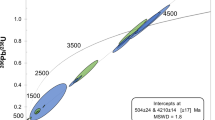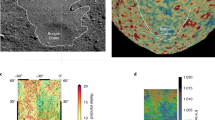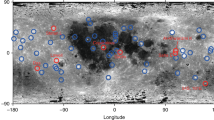Abstract
The projectiles responsible for the formation of large impact craters are often assumed to melt or vaporize during the impact, so that only geochemical traces1,2 or small fragments3,4 remain in the final crater. In high-speed oblique impacts, some projectile material may survive5,6,7, but this material is scattered far down-range from the impact site. Unusual minerals, such as magnesium-rich spinel8,9 and olivine10,11, observed in the central peaks of many lunar craters are therefore attributed to the excavation of layers below the lunar surface. Yet these minerals are abundant in many asteroids, meteorites and chondrules12,13,14,15. Here we use a numerical model to simulate the formation of impact craters and to trace the fate of the projectile material. We find that for vertical impact velocities below about 12 km s−1, the projectile may both survive the impact and be swept back into the central peak of the final crater as it collapses, although it would be fragmented and strongly deformed. We conclude that some unusual minerals observed in the central peaks of many lunar impact craters could be exogenic in origin and may not be indigenous to the Moon.
This is a preview of subscription content, access via your institution
Access options
Subscribe to this journal
Receive 12 print issues and online access
$259.00 per year
only $21.58 per issue
Buy this article
- Purchase on Springer Link
- Instant access to full article PDF
Prices may be subject to local taxes which are calculated during checkout



Similar content being viewed by others
References
Evans, N. J., Gregoire, D. C., Grieve, R. A. F., Goodfellow, W. D. & Veizer, J. Use of platinum-group elements for impactor identification: Terrestrial impact craters and Cretaceous–Tertiary boundary. Geochim. Cosmochim. Acta 57, 3737–3748 (1993).
Tagle, R. & Hecht, L. Geochemical identification of projectiles in impact rocks. Meteorit. Planet Sci. 41, 1721–1735 (2006).
Maier, W. D. et al. Discovery of a 25-cm asteroid clast in the giant Morokweng impact crater, South Africa. Nature 441, 203–206 (2006).
Kyte, F. T. A meteorite from the Cretaceous/Tertiary boundary. Nature 396, 237–239 (1998).
Pierazzo, E. & Chyba, C. F. Amino acid survival in large cometary impacts. Meteorit. Planet Sci. 34, 909–918 (1999).
Pierazzo, E. & Melosh, H. J. Hydrocode modeling of oblique impacts: The fate of the projectile. Meteorit. Planet Sci. 35, 117–130 (2000).
Bland, P. A. et al. Asteroids on the Moon: Projectile survival during low velocity impact LPSC Conference, XXXIX: Abs. #2045 (2008).
Gross, J. & Treiman, A. H. Unique spinel-rich lithology in lunar meteorite ALHA 87005: Origin and possible connection to M3 observations of the farside highlands. J. Geophys. Res. 116, E10009 (2011).
Pieters, C. et al. Mg-spinel lithology: A new rock type on the lunar farside. J. Geophys. Res. 116, E00G08 (2011).
Pieters, C. Conspicuous crater central peak: Lunar mountain of unique composition. Science 215, 59–61 (1982).
Yamamoto, S. et al. Possible mantle origin of olivine around lunar impact basins detected by SELENE. Nature Geoscience 3, 533–536 (2010).
Sunshine, J., Connolly, H. C., McCoy, T. J., Bus, S. J. & La Croix, L. M. Ancient asteroids enriched in refractory inclusions. Science 320, 514–517 (2008).
Brearley, A. J. & Jones, R. H. in Planetary Materials, Rev. Mineral Vol. 36 (eds Papike, J. J. & Ribbe, P. H.) 1–398 (Mineral. Soc. Amer., 1998).
Mittlefehldt, D. W., McCoy, T. J., Goodrich, C. A. & Kracher, A. in Planetary Materials, Rev. Mineral Vol. 36 (eds Papike, J. J. & Ribbe, P. H.) 1–195 (Mineral. Soc. Amer., 1998).
Burbine, T. H. & Binzel, R. P. Small main-belt asteroid spectroscopic survey in the near-infrared. Icarus 159, 469–499 (2002).
Dhingra, D. & Pieters, C. Mg-spinel rich lithology at crater Copernicus. LPSC Conference, XVII: Abs. #2024 (2011).
Dhingra, D. et al. Compositional diversity at Theophilus crater: Understanding the geological context of Mg-spinel bearing central peaks. Geophys. Res. Lett. 38, L11201 (2011).
Kaur, P., Chauhan, P., Bhattacharya, S., Kiran, A. J. & Kumar, S. Compositiional diversity at Tycho crater: Mg-spinel exposures detected from Moon Mineralogical Mapper (M3) data. LPSC Conference, XLIII: Abs. #1434 (2012).
Gagnepain-Beyneix, J., Lognonné, P., Chenet, H., Lombardi, D. & Spohn, T. A seismic model of the lunar mantle and constraints on temperature and mineralogy. Phys. Earth Planet Inter. 159, 140–166 (2006).
Grieve, R. A. F., Robertson, P. B. & Dence, M. R. in Multiring Basins (eds Schultz, P. H. & Merrill, R. B.) 37–57 (Pergamon, 1981).
Melosh, H. J. Impact Cratering: A Geologic Process (Oxford Univ. Press, 1989).
Pierazzo, E. & Melosh, H. J. Understanding oblique impacts from experiments, observations and modeling. Annu. Rev. Earth Planet Sci. 28, 141–167 (2000).
Eckholm, A. & Melosh, H. J. Crater features diagnostic of oblique impacts: The size and position of the central peak. Geophys. Res. Lett. 28, 623–626 (2001).
Bottke, W. F., Nolan, M. C., Melosh, H. J., Vickery, A. M. & Greenberg, R. Origin of the Spacewatch small Earth-approaching asteroids. Icarus 122, 406–427 (1996).
Minton, D. A. & Malhotra, R. A record of planet migration in the main asteroid belt. Nature 457, 1109–1111 (2009).
Chambers, J. E. A hybrid symplectic integrator that permits close encounters between massive bodies. Mon. Not. R. Astron. Soc. 304, 793–799 (1999).
Marchi, S., Mottola, S., Cremonese, G., Massironi, M. & Martellato, E. A new chronology for the Moon and Mercury. Astrophys. J. 137, 4936–4948 (2009).
Joy, K. H. et al. Direct detection of projectile relics from the end of the lunar basin-forming epoch. Science 336, 1426–1429 (2012).
De Sanctis, M. C. et al. Spectroscopic characterization of mineralogy and its diversity across Vesta. Science 336, 697–700 (2012).
Smith, D. E. et al. The lunar orbiter laser altimeter investigation on the lunar reconnaissance orbiter mission. Space Science Rev. 150, 209–241 (2009).
Acknowledgements
We gratefully acknowledge the developers of iSALE2D, the simulation code used in our research, including G. Collins, K. Wünnemann, B. Ivanov and D. Elbeshausen. We thank B. Bottke for pointing out the further implications of Mg-spinel and helpful discussion. The research was supported by the National Natural Science Foundation of China (Grant No. 41002120 and 41171355) and NASA PGG grant NNX10AU88G.
Author information
Authors and Affiliations
Contributions
Z.Y. conceived the research and implemented the Copernicus simulations with the help of B.C.J., who refined the hydrocode models to better fit the observations and created the crater profile from LOLA data; H.J.M. first realized the possibility that the olivine in Copernicus central peaks might be from the projectile; D.A.M. proved the presumption of low impact velocity on the lunar surface, and Z.Y. confirmed the similarity of mafic minerals between the central peaks and the asteroid. K.D., W.H. and Y.L. obtained and processed data used to support our research.
Corresponding author
Ethics declarations
Competing interests
The authors declare no competing financial interests.
Supplementary information
Supplementary Information
Supplementary Information (PDF 617 kb)
Rights and permissions
About this article
Cite this article
Yue, Z., Johnson, B., Minton, D. et al. Projectile remnants in central peaks of lunar impact craters. Nature Geosci 6, 435–437 (2013). https://doi.org/10.1038/ngeo1828
Received:
Accepted:
Published:
Issue Date:
DOI: https://doi.org/10.1038/ngeo1828
This article is cited by
-
Crustal remelting origin of highly silicic magmatism on the Moon
Communications Earth & Environment (2023)
-
Widespread impact-generated porosity in early planetary crusts
Nature Communications (2022)
-
Impactor material records the ancient lunar magnetic field in antipodal anomalies
Nature Communications (2021)
-
Impact remnants rich in carbonaceous chondrites detected on the Moon by the Chang’e-4 rover
Nature Astronomy (2021)
-
Origin and implications of non-radial Imbrium Sculpture on the Moon
Nature (2016)



